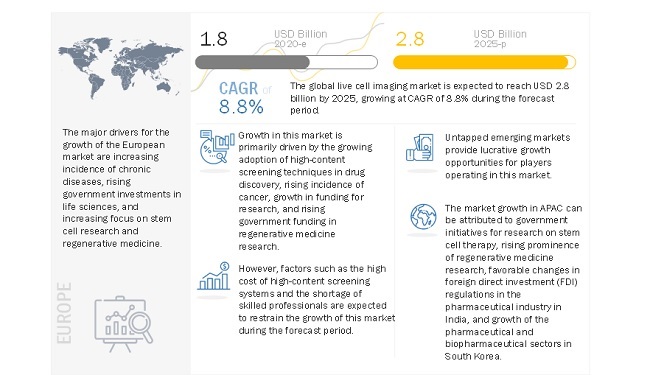According to the new market research report "Live Cell Imaging Market by Product (Instruments, Consumables, Software, Services) Application (Cell Biology, Drug Discovery) Technology (Time-lapse Microscopy, FRET) End User (Contract Research Organization, Research Institutes) - Global Forecast to 2025", published by MarketsandMarkets™, the global market size is projected to reach USD 2.8 billion by 2025 from USD 1.8 billion in 2020, at a CAGR of 8.8% during the forecast period.
Browse in-depth TOC on "Live Cell Imaging Market"
146 – Tables
40 – Figures
212 – Pages
Download PDF Brochure: https://www.marketsandmarkets.com/pdfdownloadNew.asp?id=163914483
The growing adoption of high-content screening techniques in drug discovery, rising incidence of cancer, and the growth in funding for research are the major factors driving the growth of this market.
"The reagents segment is expected for the largest share of the live cell imaging market in 2019."
Based on type, the live cell imaging consumables market is segmented into reagents, media, assay kits, and other consumables (microplates, slides, Petri dishes, coverslips, and culture chambers). In 2019, the reagents segment accounted for the largest share of 36.1% of the consumables market.

Currently, no effective treatment for COVID-19 is available in the form of vaccines or antiviral drugs, and patients are currently treated symptomatically. According to the WHO, there are 70 vaccine candidates under development, and three candidates are already being tested in human trials. At the forefront of the COVID-19 outbreak, many researchers worldwide are engaged in the viral research of SARS-CoV-2, the virus that causes COVID-19.
Live cell imaging systems, including advanced microscopy systems, help researchers investigate cellular behavior during viral research. Biomedical research requires the analysis of enormous amounts of data to develop vaccines. Therefore, major live cell imaging system providers, such as Leica Microsystems (Germany) and CytoSMART Technologies (Netherlands), have donated live cell imaging systems to assist COVID-19 researchers.



